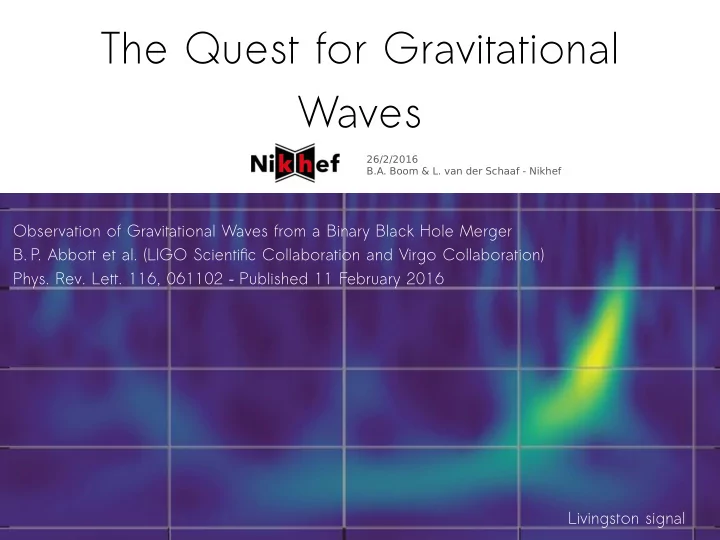

The Quest for Gravitational Waves 26/2/2016 B.A. Boom & L. van der Schaaf - Nikhef Observation of Gravitational Waves from a Binary Black Hole Merger Finally we know we work on something real B. P. Abbott et al. (LIGO Scientifc Collaboration and Virgo Collaboration) Phys. Rev. Lett. 116, 061102 – Published 11 February 2016 Laura Livingston signal
45 minutes to catch up on the work of 100 years: • A brief History • How do we measure gravitational waves? • How do we now it is gravitational waves? • What do these waves tell us? • The future of gravitational waves
Gravitation Newton’s Theory of Gravity (1687) • Gravitation is an interaction force between masses This force is instantaneous Einstein’s Theory of Special Relativity (1905) • Laws of nature are the same for all inertial observers Light travels at the same speed according to all observers Close relationship between space and time (“spacetime”) ➢ Information can travel at most with the speed of light ➢ Where does gravity ft in this view?
Gravitation Newton’s Theory of Gravity (1687) • Gravitation is an interaction force between masses This force is instantaneous Einstein’s Theory of Special Relativity (1905) • Laws of nature are the same for all inertial observers Light travels at the same speed according to all observers Close relationship between space and time (“spacetime”) ➢ Information can travel at most with the speed of light ➢ Where does gravity ft in this view? • Einstein’s Theory of General Relativity (1915) Inertial observers in curved spacetime Matter causes this curvature Gravity is a side efgect of this curvature
Curved Light Paths
Curved Light Paths in experiment Sir Arthur Eddington New York Times, November 10, 1919
Dynamics: Gravitational Waves GW’s follow from general relativity Waves in spacetime itself Coupling is very weak 44 2 1 1 10 s kg m − − − GW L-D L L+ D L time
GW150914 • Gravitational wave observed in 2 detectors 3000 km apart • Binary black hole inspiral, merger and ringdown visible • Maximum strain amplitude of 10 -21 !!!
Gravitational Wave Detectors
Tabletop “Gravitational Wave Detector” • Michelson Interferometer • Very sensitive to difgerential arm change • Strain sensitivity ~10 -9
How Small is 10 -21 Really?
The Real Thing
Beam splitter
Mirror: diameter 350 mm Mechanical polishing tot 2 nm rms Ion-beam polishing tot 0.5 nm Corrective coating to 0.3 nm over 150 mm
Vibration Isolation • Passive isolation based on pendulums • Cascading will give very steep transfers
Resulting Sensitivity
Data analysis All about gaining as much informationas possible ● With one source: ● Detect signals ● Estimate parameters: what source? Where? With several sources: ● Study populations (astrophysics) ● Cosmology (cosmic distance ladder and primordial gravitational waves)
Observation
Raw data GW150914 Get the data at: https://losc.ligo.org/events/GW150914/
Extracting the signal from the raw data ● Transient searches (arXiv:1602.03843v1) – Made for short duration transients ( ~ ms to 10 s) – Depend little on the signal morphology ● Matched fltering (arXiv:1602.03839v1) – Optimized for binary coalescence searches
Coherent WaveBurst (cWB) ● Low-latency pipeline (report of The Event with 3 min delay) ● Time-frequency analysis: Fourier transform with a window function ● Cross-correlation of the two detectors ● Classifcation: check that it does not fall in a glitch class, check some characteristic source features ● Estimate sky location and wave polarization Hanford time frequency The Event
Situation after this frst search C1: known noise C2: remaining events C3: frequency increases with time Defnition of cross-correlation: Coherence of signals: E c is the dimensionless coherent signal energy obtained by cross- correlating the two reconstructed waveforms, and E n is the dimensionless residual noise energy after the reconstructed signal is subtracted from the data.
PyCBC: matched fltering First consider an intuitive filter: Not what is happening strain = noise + signal : This is what is done Refine the filter: Recomputed every 2084 s where Matched filter signal to noise and chi-squared: Define a detection statistic:
PyCBC: matched fltering Best ftting template
Situation after second test Why are there numbers below 1? The two test discussed are responsible to make detections: afterwards the parameters of the event are properly reconstructed (with Monte Carlo methods and nested sampling algorithm).
Background estimation ● Background reduced by monitoring environment: “seismometers, accelerometers, microphones, magnetometers, radio receivers, weather, sensors, ac-power line monitors and a cosmic-ray detector” ● Uncorrelated residual background estimated with time sliding ● Event 10^6 time slides ● Sliding by 10 ms => larger than GW travel time to get uncorrelated noise
The signal after ftting to waveform models 410 +160/-180 Mpc or 0.09 +0.03/-0.04 in redshift 29 + 4 Msun 36 +5/-4 Msun Final mass = 62 + 4 Msun A wonderful chance to test GR! Final spin = 0.67 +0.05/-0.07
Predict parameters and compare
QNM frequency of black hole
Deviations from best ft waveform
More on deviations GR performed very well in this test ...
Graviton wavelength bound By using: and
Future ● More detectors (Advanced Virgo, Kagra, LigoIndia) ● More (diverse) sources (neutron stars, black holes, supernovas, primordial gravitational waves, … ? ) ● Difgerent types of detectors (ET, eLISA)
Recommend
More recommend